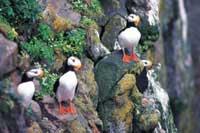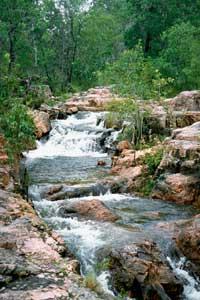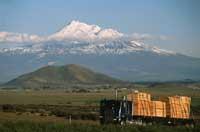Economic Ecology
2000/09/03 Carton Virto, Eider - Elhuyar Zientzia
This attitude is changing in countries like Australia and Costa Rica. Last May, the Australian company Earth Sanctuaires was the first company to quote on the stock market for conservation. The company acquired land and recovered native flora and fauna, which now reports ecological tourist benefits. They managed to modify the laws that establish the value of the goods and declare as assets the animal species that host them.

Since 1997, the Government of Costa Rica has paid with money the services provided by ecosystems: capture of carbon dioxide by plants, protection of rivers and biodiversity or preservation of the beauty of the landscape. The money is paid to the owners who care for their lands and has meant greater protection and recovery of ecosystems. The payments are obtained from taxes on fossil fuels and carbon credits sold to several European nations. These government initiatives have been supported by scientists and industries.
How much price?
With the aim of controlling the floods, filtering the water, ensuring the fertility of the soil, stabilizing the climate or the enjoyment of the human being, ecosystems are being protected and recovered throughout the world, developing new economic mechanisms. We have begun to put price on nature; to give economic value and to pay to what until now was taken in return. The timber industries, for example, will have to change the ecological functions that will not meet the cutting trees.
Before putting the amount you have to establish how the ecosystem generates services and how it interacts between them. To begin with, it is essential to count the sources of services offered by the ecosystem and consumers. To do this, we must take into account the services that the concrete ecosystem offers to the place, the region and the planet. The control of mosquitoes, the contribution to the prevention of floods or the stabilization of the climate result in local, regional and planetary benefit, respectively, and all these services must be valued economically. But to say is easier than to do.

The value of a particular ecosystem depends on eleven factors. The time involved in providing services and their recovery, for example, are critical points, but both features are little understood and will remain so for the moment. Ecosystems do not respond linearly to mixtures. In Australia, for example, although farmers do not realize it, the soil has been salted for decades and has reached a critical level. With the planting of native flora it is possible to reduce the degree of salinity (benefit), but at the same time the flow of rivers is reduced (cost). What's more, each ecosystem has its peculiarities, that is, what is done in one place may not serve for anything elsewhere. That's what happens in Australia. It has been possible to reduce salinity through the installation of plants in the east, but for this road to bear fruit in the west it would have to put a huge amount of money. In order to carry out the theory and give economic value to an ecosystem, it is essential to have local information.
Bases for the evaluation
To begin with, throughout the evaluation process, it is necessary to combine the ecological and economic point of view and follow three steps.
One: identify all alternatives. The first step is the most important and, at the same time, the most despised of all, and many times it is done following a vision too small. If a city wants to expand its water treatment system, engineers will study the different types of water treatment plants, and they will probably forget options based on natural ecosystems.
Two: identify and measure the effects of each alternative, from current inputs to long-term biophysical and social effects. It is rare to have enough data to make accurate estimates, but it is important to calculate the doubts and risks that may be the development of the process.

Three: assess how human well-being will affect ecosystem conservation as it is or progress in each alternative, both in the present and in the future. Depending on each alternative, human beings will access a number of services and goods, but they must also renounce other resources. The condition is measured by the difference between both pathways and economic units are used.
Limits of the evaluation
Evaluating ecosystem assays are in practice with the oldest problems in the economy: detecting and grouping priorities and managing uncertainty. All methods of calculation of value present difficulties: the market price does not reflect on many occasions the real cost of the product and, on the other hand, most of the services offered by ecosystems are out of the market. The methods of prioritization are not valid to calculate the value of the possession of certain goods. Depending on the fertility difference between contaminated lands and clean soils, a clean air value can be established, but how is the satisfaction generated by looking at the rainforest measured?
A promising bet
The validation of ecosystems is a guide to organizing information and helping to make decisions, but it is neither the objective nor the end of the path, but a tool more available to the authorities. But to make it profitable we must help other initiatives: to make an adequate economic policy and warn the individual of the value of ecosystem goods. When the benefits are much higher than the costs, a project has great possibilities to move forward and, in that sense, those who were previously erroneous when valuing ecosystems can now become virtues. As for the purification of water, it is assumed that the value of natural filtration is the cost of the filter and, although its real value is greater, it has been an impulse in favor of natural systems of purification in different points of the world. There and here, they have realized that the conservation and recovery of natural purification systems is cheaper than the construction of scrubbers and, above, has an added economic value.

Initiatives that take into account the interdependence of ecosystem services have also been launched. Australia and Costa Rica are two of the eco-economic projects that were born with the aim of controlling salinity and capturing carbon dioxide from the atmosphere, but hopefully they will also protect other services that are not understood so well. The echo and demand of initiatives that combine ecology, economy and society are growing. The footprint has only been opened.
Published in the supplement Natura de Gara

Gai honi buruzko eduki gehiago
Elhuyarrek garatutako teknologia





